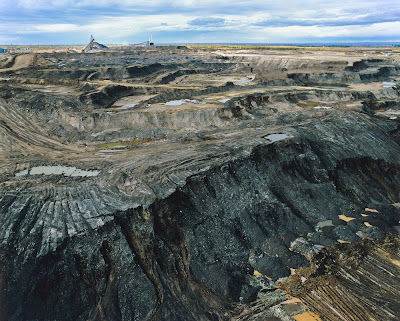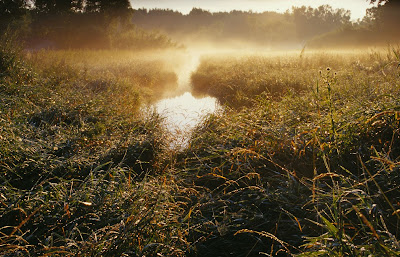Lost! What a peculiar sensation; one made more than a little surreal because I can hear traffic from...some direction. And I could set my watch by the planes that rumble low over me as they throttle down to land at nearby O’Hare airport. How can I be lost in the woods and still be so obviously surrounded by civilization?
I dropped Lynn off at the airport around 7:30. Then, not wanting to drive in rush hour traffic anywhere near Chicago, I picked the nearest green spot on the map to explore for a while. Cook County has a marvelous series of forest preserves along the Des Plaines River. I pulled into one with a rather aristocratic-sounding name: Catherine Chevalier Woods. Three cars were parked in the long, curved lot carved out of the trees. Their occupants sat inside them. I headed into the woods.
A wide gravel path led towards the river. A thunderstorm had left standing water that mirrored the foliage. I disturbed a flock of mallards waddling in the puddles. Just me and the ducks out here in the wet woods today. Oh, and the deer. Every couple hundred yards heads pop up from browsing to stare as I pass. The only thing more regular than the deer are the jets flying overhead.
The river is high and the water gray-brown. It moves silently, massively, inexorably. The water tugs at the lower tree branches dipping into it. Sodden logs and buoyant plastic bottles sweep swiftly past. Trees that normally anchor the bank now stand in the river. When the gravel path veers away into the woods, I leave it for a narrower riparian track. The earth, though wet, is still hard. The night’s downpour did not last long enough to soften and melt the cracks in the mud—or the innumerable animal tracks.

So, I’m walking farther and farther, wondering when I’ll get to the bend in the river I’d seen on the map, thinking maybe I should turn around. But I prefer completing a loop to backtracking, so I venture on into ever wilder surroundings. Finally, just as I reach the expected bend, the sun bursts through lingering clouds. Its rays dapple the forest floor, highlighting fresh irises, and surprisingly colorful mosses. Another of the endless cast of deer stands in a spotlight. An enormous blue airbus, visible in snatches through the tree canopy, shrieks and shudders as it slowly descends.
The faint trail that I’ve been following peters out entirely as I reach a flood engorged slough that curves away from the river back in the direction I know the car must be. Trusting my intuition, sense of direction, and memory of the map that I neglected to bring along, I plunge forward. Tangles of driftwood deposited by greater floods than today’s create an obstacle course. Here, finally, is my wilderness: hot, humid, muddy, choked with obstructions, and throwing a cloud of mosquitoes in my face.
I begin to doubt. The traffic I’ve been ignoring seems louder, but directionless, all around, like the mosquitoes. So predictable until now, the planes are flying the wrong way, too. Have they switched to taking off? I misjudged the distance; what else? Suddenly I realize, I’m lost. Later, when I’m not tired, sweaty, and swatting mosquitoes furiously, I will laugh at my predicament. Me, lover of the urban wilderness, lost in one. It’s fitting, really—and strangely satisfying; even beautiful. I try to savor the feeling, for I know it won’t last. I will find the river and the parking lot and the city that surrounds me. As I drive home I will also try to preserve this dizzying sensation of wonder, this uncommon experience—a gift of Chicago’s wilderness.
Every city needs its wildernesses.
To see more photos go to my
flickr page.
To learn more about Chicago area parks go to
Chicago Wilderness, where you'll find that June is Leave No Child Inside month. Nice.




















